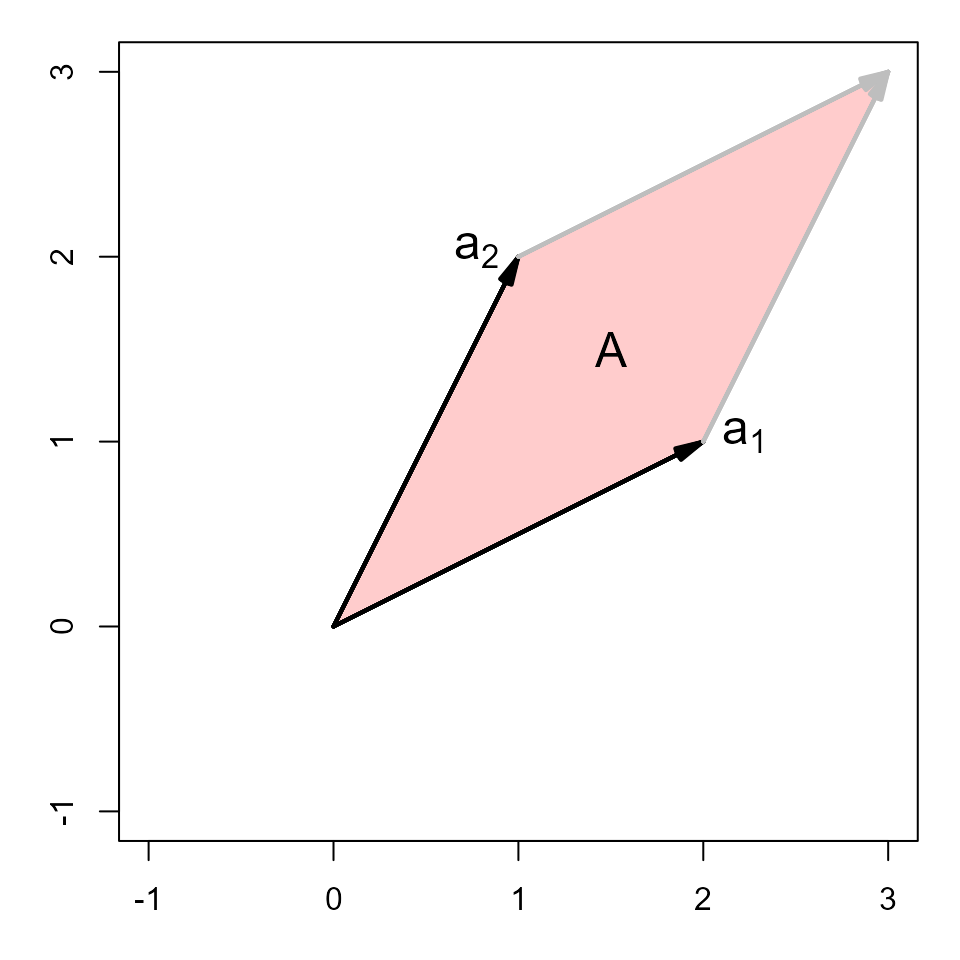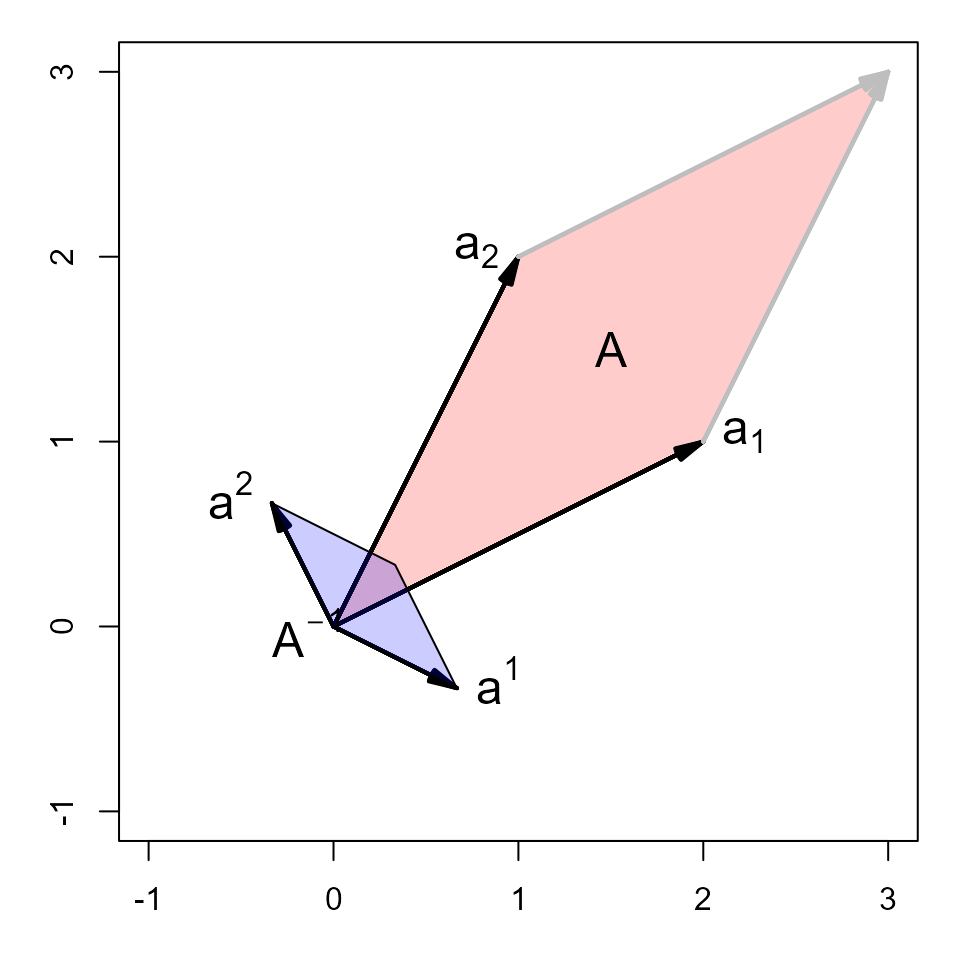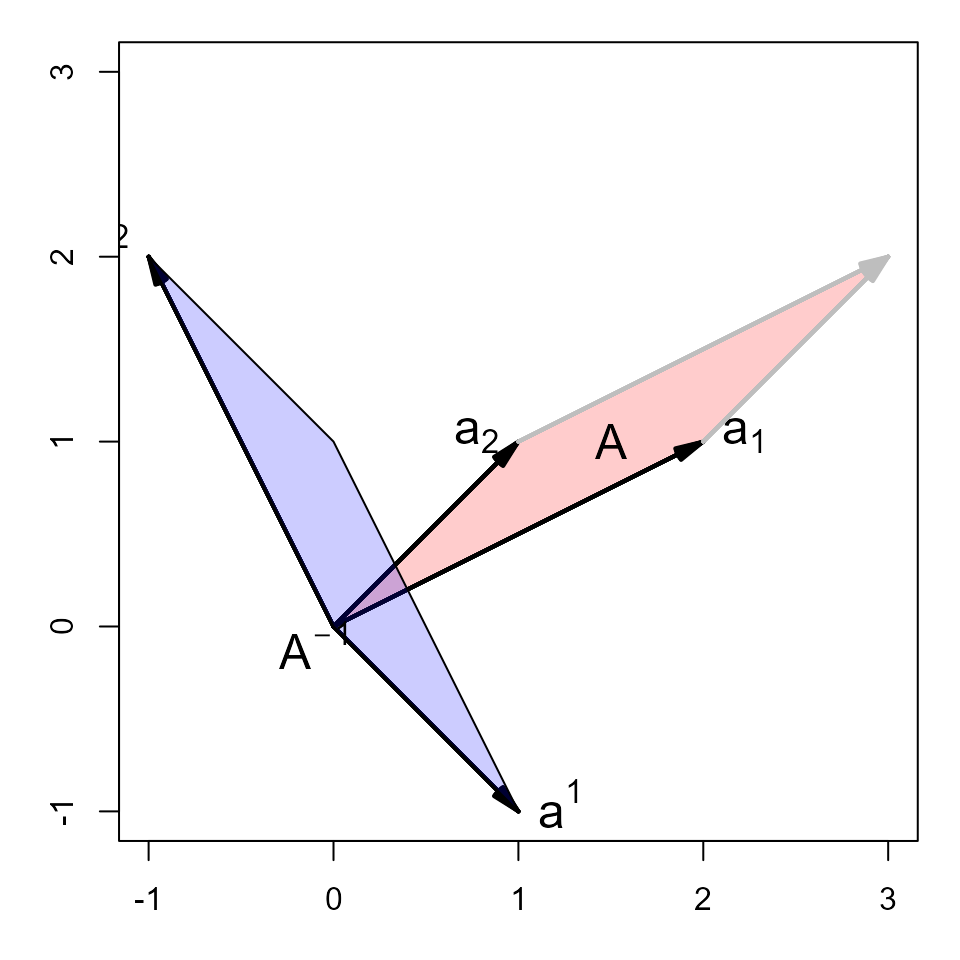
3. Inverse of a matrix
Michael Friendly
November 24, 2024
Source:vignettes/a3-inv-ex1.Rmd
a3-inv-ex1.RmdThe inverse of a matrix plays the same roles in matrix algebra as the reciprocal of a number and division does in ordinary arithmetic: Just as we can solve a simple equation like for by multiplying both sides by the reciprocal we can solve a matrix equation like for the vector by multiplying both sides by the inverse of the matrix ,
The following examples illustrate the basic properties of the inverse of a matrix.
Load the matlib package
This defines: inv(), Inverse(); the
standard R function for matrix inverse is solve()
Basic properties
1. det(A) != 0, so inverse exists
Only non-singular matrices have an inverse.
(AI <- inv(A))## [,1] [,2] [,3]
## [1,] 0.0625 0.0625 0.125
## [2,] 0.6875 -0.3125 -0.625
## [3,] 0.2500 0.2500 -0.5002. Definition of the inverse:
or AI * A = diag(nrow(A))
The inverse of a matrix is defined as the matrix which multiplies to give the identity matrix, just as, for a scalar , .
NB: Sometimes you will get very tiny off-diagonal values (like
1.341e-13). The function zapsmall() will round
those to 0.
AI %*% A## [,1] [,2] [,3]
## [1,] 1 0 0
## [2,] 0 1 0
## [3,] 0 0 13. Inverse is reflexive:
inv(inv(A)) = A
Taking the inverse twice gets you back to where you started.
inv(AI)## [,1] [,2] [,3]
## [1,] 5 1 0
## [2,] 3 -1 2
## [3,] 4 0 -14. inv(A) is symmetric if and only if
A is symmetric
## [,1] [,2] [,3]
## [1,] 0.0625 0.6875 0.25
## [2,] 0.0625 -0.3125 0.25
## [3,] 0.1250 -0.6250 -0.50## [1] FALSE
is_symmetric_matrix( inv( t(A) ) )## [1] FALSEHere is a symmetric case:
## [,1] [,2] [,3]
## [1,] 0.50 -0.25 -0.25
## [2,] -0.25 0.50 0.00
## [3,] -0.25 0.00 0.50## [,1] [,2] [,3]
## [1,] 0.50 -0.25 -0.25
## [2,] -0.25 0.50 0.00
## [3,] -0.25 0.00 0.50## [1] TRUE
is_symmetric_matrix( inv( t(B) ) )## [1] TRUE## [1] TRUEMore properties of matrix inverse
1. inverse of diagonal matrix = diag( 1/ diagonal)
In these simple examples, it is often useful to show the results of
matrix calculations as fractions, using
MASS::fractions().
## [,1] [,2] [,3]
## [1,] 1 0.0 0.00
## [2,] 0 0.5 0.00
## [3,] 0 0.0 0.25## [,1] [,2] [,3]
## [1,] 1 0 0
## [2,] 0 1/2 0
## [3,] 0 0 1/42. Inverse of an inverse: inv(inv(A)) = A
## [,1] [,2] [,3]
## [1,] 1 2 3
## [2,] 2 3 0
## [3,] 0 1 23. inverse of a transpose:
inv(t(A)) = t(inv(A))
## [,1] [,2] [,3]
## [1,] 1.50 -1.0 0.50
## [2,] -0.25 0.5 -0.25
## [3,] -2.25 1.5 -0.25## [,1] [,2] [,3]
## [1,] 1.50 -1.0 0.50
## [2,] -0.25 0.5 -0.25
## [3,] -2.25 1.5 -0.254. inverse of a scalar * matrix:
inv( k*A ) = (1/k) * inv(A)
inv(5 * A)## [,1] [,2] [,3]
## [1,] 0.3 -0.05 -0.45
## [2,] -0.2 0.10 0.30
## [3,] 0.1 -0.05 -0.05
(1/5) * inv(A)## [,1] [,2] [,3]
## [1,] 0.3 -0.05 -0.45
## [2,] -0.2 0.10 0.30
## [3,] 0.1 -0.05 -0.055. inverse of a matrix product:
inv(A * B) = inv(B) %*% inv(A)
## [,1] [,2] [,3]
## [1,] 9 20 10
## [2,] 5 13 12
## [3,] 5 11 4## [,1] [,2] [,3]
## [1,] 4.0 -1.50 -5.50
## [2,] -2.0 0.70 2.90
## [3,] 0.5 -0.05 -0.85## [,1] [,2] [,3]
## [1,] 4.0 -1.50 -5.50
## [2,] -2.0 0.70 2.90
## [3,] 0.5 -0.05 -0.85This extends to any number of terms: the inverse of a product is the product of the inverses in reverse order.
## [,1] [,2] [,3]
## [1,] 77 118 49
## [2,] 53 97 42
## [3,] 41 59 24## [,1] [,2] [,3]
## [1,] 1.5 -0.59 -2.03
## [2,] -4.5 1.61 6.37
## [3,] 8.5 -2.95 -12.15## [,1] [,2] [,3]
## [1,] 1.5 -0.59 -2.03
## [2,] -4.5 1.61 6.37
## [3,] 8.5 -2.95 -12.15
inv(ABC)## [,1] [,2] [,3]
## [1,] 1.5 -0.59 -2.03
## [2,] -4.5 1.61 6.37
## [3,] 8.5 -2.95 -12.15Geometric interpretations
Some of these properties of the matrix inverse can be more easily understood from geometric diagrams. Here, we take a non-singular matrix ,
## [,1] [,2]
## [1,] 2 1
## [2,] 1 2
det(A)## [1] 3The larger the determinant of , the smaller is the determinant of .
## [,1] [,2]
## [1,] 2/3 -1/3
## [2,] -1/3 2/3
det(AI)## [1] 0.3333Now, plot the rows of
as vectors
from the origin in a 2D space. As illustrated in
vignette("a1-det-ex1"), the area of the parallelogram
defined by these vectors is the determinant.
par(mar=c(3,3,1,1)+.1)
xlim <- c(-1,3)
ylim <- c(-1,3)
plot(xlim, ylim, type="n", xlab="X1", ylab="X2", asp=1)
sum <- A[1,] + A[2,]
# draw the parallelogram determined by the rows of A
polygon( rbind(c(0,0), A[1,], sum, A[2,]), col=rgb(1,0,0,.2))
vectors(A, labels=c(expression(a[1]), expression(a[2])), pos.lab=c(4,2))
vectors(sum, origin=A[1,], col="gray")
vectors(sum, origin=A[2,], col="gray")
text(mean(A[,1]), mean(A[,2]), "A", cex=1.5)
The rows of the inverse can be shown as vectors from the origin in the same space.
vectors(AI, labels=c(expression(a^1), expression(a^2)), pos.lab=c(4,2))
sum <- AI[1,] + AI[2,]
polygon( rbind(c(0,0), AI[1,], sum, AI[2,]), col=rgb(0,0,1,.2))
text(mean(AI[,1])-.3, mean(AI[,2])-.2, expression(A^{-1}), cex=1.5)
Thus, we can see:
The shape of is a rotation of the shape of .
is small in the directions where is large.
The vector is at right angles to and is at right angles to
If we multiplied by a constant to make its determinant larger (by a factor of ), the inverse would have to be divided by the same factor to preserve .
One might wonder whether these properties depend on symmetry of
,
so here is another example, for the matrix
A <- matrix(c(2, 1, 1, 1), nrow=2), where
.
## [,1] [,2]
## [1,] 2 1
## [2,] 1 1
(AI <- inv(A))## [,1] [,2]
## [1,] 1 -1
## [2,] -1 2The areas of the two parallelograms are the same because
.
